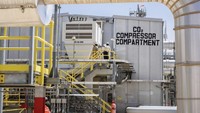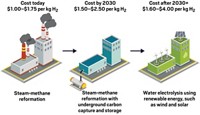Advertisement
Grab your lab coat. Let's get started
Welcome!
Welcome!
Create an account below to get 6 C&EN articles per month, receive newsletters and more - all free.
It seems this is your first time logging in online. Please enter the following information to continue.
As an ACS member you automatically get access to this site. All we need is few more details to create your reading experience.
Not you? Sign in with a different account.
Not you? Sign in with a different account.
ERROR 1
ERROR 1
ERROR 2
ERROR 2
ERROR 2
ERROR 2
ERROR 2
Password and Confirm password must match.
If you have an ACS member number, please enter it here so we can link this account to your membership. (optional)
ERROR 2
ACS values your privacy. By submitting your information, you are gaining access to C&EN and subscribing to our weekly newsletter. We use the information you provide to make your reading experience better, and we will never sell your data to third party members.
Environment
A Plan For Sustainability
August 13, 2007
| A version of this story appeared in
Volume 85, Issue 33
Lack of sustainability and global warming may be linked. Inappropriate use of resources may be a primary cause of warming. For example, consider a glass jar of a condiment that is replaced every two months. The old jars are thrown away and always end up in landfills. Over a lifetime, large amounts of fossil fuels are burned as a consequence of remanufacturing the jars. By bringing the cleaned jars back to the store where they were purchased and by using a discount scheme as an incentive for the part exchange of a new jar of condiment, an enormous source of industrial emissions is removed (if one extrapolates to the whole waste stream).
The cleaned jars could be sterilized and refilled by the manufacturer at a cost comparable to endlessly purchasing new jars from the glassworks. The glassworks, after an initial period of lost revenue, would see renewed profits as disposable food containers are replaced with recyclable ones. The source of energy for melting new glass would be producer gas or methane from the waste stream (which would now become valuable). Hence, nothing would end up in a landfill.
Cars and other big-ticket items that have become worn out or obsolete could all be recycled (perhaps in a modular fashion, in which usable parts are recycled as much as possible). Currently, although most U.S. cars are recycled, they are mainly crushed and melted.
Cellulose-based fuel (which is only 37% combustible) would not be cost-effective compared with coal, oil, tar sands, and natural gas. Hence, products shipped to the U.S. that use fossil fuels in manufacturing would have to be subject to an import carbon tax. The tax revenue would be used in carbon fixation projects.
Waste gasifiers and steam reformers are not exorbitantly priced and may be considered low-tech. Some form of incentive, however, such as a waste credit or tax write-off, would be required to encourage the use of waste as fuel.
This might occur by balancing a carbon tax on all fossil-fuel emissions (on the debit side) with a system of carbon credits. In a global sense, carbon credits would be allocated for using and making green fuels and other alternative sources of energy such as solar mirror arrays, for example. Hence, an electric power company that burns coal could offset its fossil-fuel emissions by using sewer gas, garbage as green fuel, or solar reflectors linked to a steam turbine.
Over time, the fossil carbon tax would increase and the consequently subsidized credits would also increase. Electric companies would thus have the opportunity to undergo a green transformation by using their own profits. Consumers of gasoline would be able to offset part of a carbon tax by extensive recycling of their carefully separated and weighed garbage. A carbon credit/debit card could be used.
To avoid using fossil fuels, concrete, brick, steel, and aluminum manufacturers might have to relocate to desert areas with abundant sunshine that could activate their solar mirror arrays and provide intense heat. They would also reap additional profits through use of credits. In fact, Alcoa is already contemplating moving to Iceland to use geothermal power.
By yoking the world's economic systems to the carbon cycle (using a carbon tax and carbon credits as incentives), the problem of global warming could be solved. Refocusing the world's industries would eventually provide additional employment to manufacturers of domestic waste gasifiers, steam reformers, solar ovens, plastic construction materials, new ceramics, greatly modified plastic cars, and steel substitutes, for example.
If stimulated correctly, the economics of manufacturing in the Western world could benefit greatly and become competitive again with the East. Though this proposal appears attractive in principle, in reality, if clumsily implemented, it would create a widespread recession due to decreased demand for goods. It would take time for the whole economic system to reconfigure itself. During this time, large-scale public works involving waste conversion/combustion and recycling projects would be required to maintain full employment and avoid public unrest or even wars. When one considers that almost everything we make is eventually thrown away, the feasibility of a mandatory recycling program becomes obvious.
By using the organics in the waste stream as a largely carbon-neutral principal fuel and recycling all the incombustibles, an approximate reduction of 60% CO2 emissions can be envisaged. The deficit of 40% could be made up by using solar mirror arrays linked to a steam turbine (rather than by using nuclear fuel). Waste could be our main source of liquid and gaseous fuel as well as raw and manufactured materials.
This model has both scientific and philosophical implications. Human activity may well be directly linked to the amount of waste produced and the degree of atmospheric warming. I believe the relationships may be linear. By cutting the waste stream out from human society, warming could be greatly reduced.
Paul Comet
Houston




Join the conversation
Contact the reporter
Submit a Letter to the Editor for publication
Engage with us on Twitter